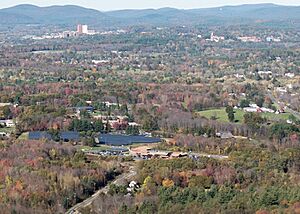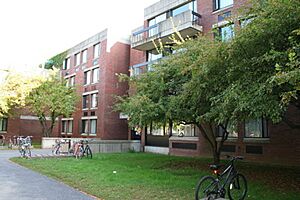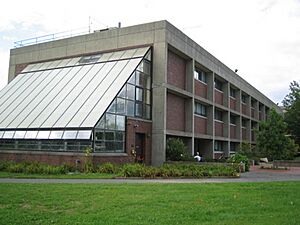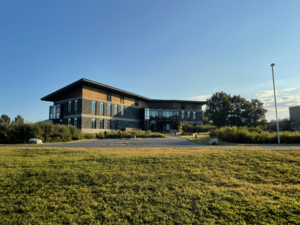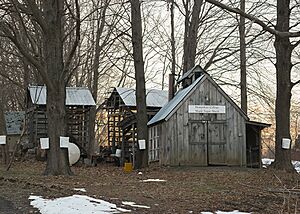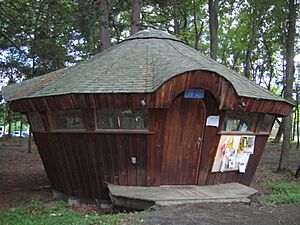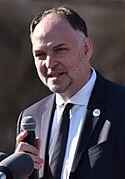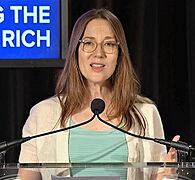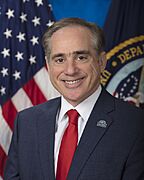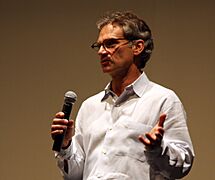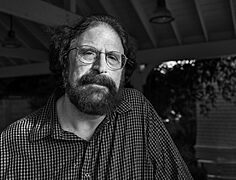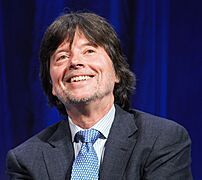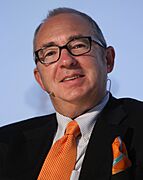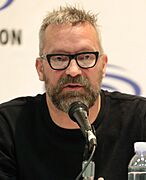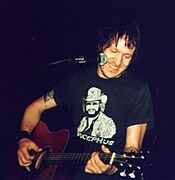Hampshire College facts for kids
 |
|
| Motto | "Non satis scire" |
|---|---|
|
Motto in English
|
"To Know Is Not Enough" |
| Type | private liberal arts college |
| Established | 1965 |
| Accreditation | NECHE |
| Endowment | $54.5 million (2022) |
| Budget | $35.7 million |
| President | Jennifer Chrisler (interim) |
|
Academic staff
|
145 (Fall 2018) |
|
Administrative staff
|
115 |
| Undergraduates | 716 (2023–2024) |
| Location |
,
Massachusetts
,
United States
42°19′30″N 72°31′51″W / 42.3249°N 72.5308°W |
| Campus | Rural, 800 acres (3.2 km2) |
| Colors | Teal, black, forest green, gold |
| Affiliations | Five College Consortium CLAC Project Pericles NAICU |
Hampshire College is a private college in Amherst, Massachusetts. It's a special kind of school called a liberal arts college. It opened in 1970. The college was started as an experiment in new ways of learning. It works closely with four other colleges nearby. These are Amherst College, Smith College, Mount Holyoke College, and the University of Massachusetts Amherst. Together, they are known as the Five College Consortium.
The campus is also home to the National Yiddish Book Center and the Eric Carle Museum of Picture Book Art. It also hosts the yearly Hampshire College Summer Studies in Mathematics.
Hampshire College uses a unique way of teaching. It focuses on students choosing what they want to study. Instead of regular grades, students get detailed written reports about their work. They also build portfolios to show what they've learned.
In 2019, the college faced some challenges. There were talks about it joining with another school. But students and teachers wanted it to stay independent. Because of this, the college started a plan to make sure it could stay strong on its own.
Contents
College History
The idea for Hampshire College began in 1958. Leaders from nearby colleges wanted to find new ways to teach. They wrote a report called "The New College Plan." This plan suggested many ideas that Hampshire College uses today. These ideas include students designing their own studies. It also focuses on students learning how to keep educating themselves. The plan emphasized students' curiosity and learning across different subjects. It also highlighted close relationships between students and teachers.
In 1965, a person named Harold F. Johnson gave $6 million to start Hampshire College. The Ford Foundation also gave money. With these funds, the college bought 800 acres of land in Massachusetts. Construction then began.
An important book about the college's start is The Making of a College. It was written by the college's first president, Franklin Patterson. Hampshire College welcomed its first students in 1970. In its early years, many students wanted to attend. This made it one of the hardest colleges to get into. Over time, the number of applications changed. But in the late 1990s, more students applied again.
The college has faced money challenges over the years. It didn't have a large starting fund to rely on. So, it depended a lot on money from student tuition. In recent years, the college has become more financially stable. This was helped by fundraising efforts.
In the mid-1990s, Hampshire College started a "cultural village." This allowed other non-profit groups to have offices on its campus. These groups include the National Yiddish Book Center and the Eric Carle Museum of Picture Book Art. The Hitchcock Center for the Environment is also part of this village.
Adele Simmons was the college's third president. Gregory Prince was the fourth president. He served the longest, from 1989 to 2005. Ralph Hexter became president in 2005. Jonathan Lash was the sixth president, serving until 2018. He was known for his work on global sustainability. Miriam Nelson became president in 2018. She resigned in 2019 after a plan to merge with another school didn't work out.
In 2012, the college started a scholarship fund. This fund helps students who don't have legal documents to get a degree. It provides over $25,000 each year for tuition.
Rebuilding After Challenges
In January 2019, the college announced it was looking for a partner school. This was to help with its financial future. They also thought about not accepting new first-year students for a short time. This news caused many students and alumni to protest. They wanted more information and for their voices to be heard. Students held sit-ins in college offices.
After these events, several leaders at the college resigned. The college then decided to focus on staying independent. They started a fundraising campaign. Alumnus Ken Burns, a famous filmmaker, helped lead this effort. Ed Wingenbach became the new president in August 2019.
More information came out later. The University of Massachusetts Amherst had considered a partnership. But it would have meant closing Hampshire College and laying off many staff. Hampshire wanted to keep its name and unique way of learning. In the end, they couldn't agree.
In September 2019, the first-year class was small. The total number of students was also lower than usual.
How Hampshire is Rebuilding
The fundraising campaign, Change in the Making: A Campaign for Hampshire, started in late 2019. Its goal was to raise $60 million by 2024. By March 2023, almost $40 million had been raised. Ken Burns continued to help. In November 2020, the college received its largest single donation ever. It was $5 million from alumnus James S. Crown and his wife. Another alumnus, Dr. Lucy McFadden, gave $2 million. In January 2022, an anonymous gift of $5 million was given. This money helps fund the Ken Burns Initiative to Transform Higher Education. In January 2023, Stonyfield Yogurt cofounder and alumnus Gary Hirshberg invested $1 million.
In 2021, the college improved its admissions process. This led to a big increase in new students. In fall 2022, Hampshire welcomed its largest group of new students since 2018.
In 2020, Hampshire changed how its academic departments were organized. It now focuses on big global challenges. These include climate change and social justice.
The college celebrated its 50th anniversary in October 2021. Many alumni, families, and former staff came back to campus.
In March 2023, Hampshire College offered a special invitation. Students from New College of Florida could transfer to Hampshire. Hampshire would match their current tuition cost. This was in response to changes happening at New College of Florida.
College Presidents
- Franklin Patterson (1966–1971)
- Charles R. Longsworth (1971–1977)
- Adele S. Simmons (1977–1989)
- Gregory S. Prince, Jr. (1989–2005)
- Ralph J. Hexter (2005–2010)
- Marlene Gerber Fried (2010–2011) (interim)
- Jonathan Lash (2011–2018)
- Miriam E. Nelson (2018–2019)
- Kenneth Rosenthal (2019) (interim)
- Edward Wingenbach (2019–2025)
- Jennifer Chrisler (2025) (interim)
Sports and Activities
Hampshire College sports teams are called the Black Sheep. The college is part of the United States Collegiate Athletic Association (USCAA). They mostly compete in the Yankee Small College Conference (YSCC).
Hampshire has eight varsity sports. These include basketball, cross country, soccer, and track & field.
Campus Publications
The oldest student publication at Hampshire is The Omen literary magazine. It first came out in 1993. The magazine welcomes writing from all students.
Academics and Learning
How Students Learn
Hampshire College is approved by the New England Commission of Higher Education. The college says it is "experimenting" with education. This means its way of teaching is always changing. Since it started, the college has had some unique features:
- It focuses on project work instead of just regular classes.
- Students get detailed written reports about their work. They don't get letter grades.
- The learning is based on student interests. Students play a big part in planning their own studies.
- It emphasizes students being motivated and organized on their own.
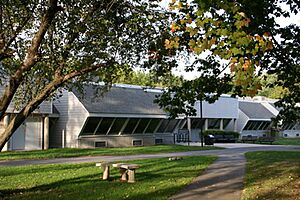
The college divides learning into three "divisions" instead of four years:
- Division I: Exploring and Working Across Subjects
- Division II: Focusing on a Main Subject
- Division III: Creating New Knowledge
Division II usually takes two years. Divisions I and III each take one year.
In 2021, the most popular subjects for graduates were:
- Creative Writing
- Art/Art Studies
- Film/Video & Photographic Arts
- Sociology
Schools and Programs
Hampshire College teachers are organized into different Schools of thought:
- Cognitive Science (CS): This includes subjects like how the mind works, language, and computer science.
- Humanities, Arts, and Cultural Studies (HACU): This includes film, art, literature, music, and philosophy.
- Critical Social Inquiry (CSI): This includes sociology, history, and politics.
- Natural Science (NS): This includes traditional sciences like biology, chemistry, and math.
- Interdisciplinary Arts (IA): This includes theater, creative writing, and social entrepreneurship.
The Five College Program in Peace and World Security Studies (PAWSS) is based at Hampshire. The national organization Civil Liberties and Public Policy (CLPP) also works on campus. In 2014, Hampshire started a new study area called Psychoanalytic Studies.
Five College Consortium
Hampshire College is the newest school in the Five-College Consortium. The other schools are Amherst College, Mt. Holyoke College, Smith College, and the University of Massachusetts Amherst.
Students at any of these schools can take classes at the others. They can also borrow books from any of the libraries. They can use resources like dining halls. The five colleges together offer over 5,300 courses. Their libraries have more than eight million books. Buses run between the schools.
There are two subjects that are taught jointly across the five colleges: Dance and Astronomy.
Admissions
Hampshire College stopped requiring SAT and ACT scores from applicants in 2014. They wanted to focus on other ways to see if a student would do well. They believed these tests might not be fair to all students. Because of this, Hampshire was no longer included in the U.S. News & World Report college rankings. The college said this change led to fewer applications, but the students who did apply were often a better fit and more diverse.
Caring for the Planet
The R.W. Kern Center
The R.W. Kern Center opened in 2017. It is a very special building. It is one of only a few buildings in the world certified as a "Living Building." This means it creates all its own energy and water. It also handles all its own waste. The building uses solar panels for power. It collects rainwater for drinking. It even has special composting toilets. The materials used to build it were carefully chosen to be good for the environment. The Kern Center has admissions offices, classrooms, and student lounges. It also has a coffee shop.
Climate Action Plan
Hampshire College has a plan to reduce its energy use by 50% in the next 20 years. This is a big goal in their Climate Action Plan. They plan to update several buildings to make them more energy-efficient. A $1 million gift is helping to make this plan possible.
Solar Power
Hampshire College aimed to be the first college in the United States to be 100% solar powered. This is part of their goal to be "climate-neutral" by 2020. They started building a large solar panel field in 2015. Since June 2017, part of this solar field has been powering the college. The solar panels cover 19 acres and have 15,000 panels. They produce a lot of electricity.
The college expects to save a lot of money on electricity costs. The solar power also helps the environment. It avoids a lot of greenhouse gases. This is like taking hundreds of cars off the road. Other solar panels on campus also add to the power. These are on the Kern Center, a barn, the president's house, and an arts center. The college president said that switching to clean energy is "the right thing to do" for the planet.
In February 2023, the college announced it had reached its goal. It became carbon neutral for all campus emissions. This includes electricity and heating.
Timeline of Sustainability Efforts
Since 2011, Hampshire College has worked on many projects to be more sustainable. This means being more environmentally friendly.
- In 2011, it was the first college to stop investing in fossil fuels.
- In 2012, they created their Climate Action Plan.
- The Hampshire College Farm expanded its education programs.
- In 2014, a main parking lot was removed and turned into a meadow. They also stopped mowing many lawns. This helps reduce pollution and creates homes for wildlife.
- In 2014, they installed an electric car charging station.
- In 2015, they protected 46 acres of their land.
- In 2016, the Kern Center became their first building with zero emissions.
- In 2017, Hampshire College promised to keep supporting climate action. They signed the "We Are Still In" campaign. This means they support the goals of the Paris Climate Agreement.
Student Groups and Ideas
In 2004, a student group called Re-Radicalization of Hampshire College (Re-Rad) formed. They felt the college was moving away from its original ideas. They wanted to bring back the focus on alternative education. The group held a protest. The college community generally supported their ideas.
Re-Rad was responding to changes in the first-year program. These changes meant first-year students no longer had to do independent projects. Re-Rad suggested their own ideas, but they were not put into action.
The Re-Radicalization group did help start a program. It paired newer students with older students. They worked together on small projects.
Students at Hampshire often think about the college's founding ideas. They challenge the college to stay true to its original mission. Other student groups have also tried to make similar changes over the years.
Campus Discussions
Investments
In 1977, Hampshire was the first college to stop investing in companies that supported apartheid in South Africa. This was a system of unfair treatment. In 2009, there were reports that Hampshire College had stopped investing in companies connected to Israel. This was due to concerns about human rights. However, the college president later said these changes were not for political reasons.
American Flag
After the 2016 presidential election, students at Hampshire lowered the American flag to half-staff. This was a protest against feelings of fear. The college allowed the flag to stay at half-staff. The college president said some students felt the flag was a "symbol of fear." Later, the flag was burned. It was replaced, and the college continued to fly it at half-staff. This was to remember deaths from violence.
After some public discussion, the college stopped flying the flag temporarily. This led to protests from people who wanted the flag back. On December 2, 2016, the college decided to raise the flag to full staff.
In the Media
In 2001, Hampshire College students voted against the War on Terrorism. This was a first for a college and got national attention.
Saturday Night Live had a sketch called "Jarret's Room" that was supposedly set at Hampshire College. However, it showed things the college doesn't have, like fraternities or a football team. It also incorrectly said the college was in New Hampshire.
In the film The Last Days of Disco, two characters are recent Hampshire graduates.
Alumnus Ken Burns said Hampshire College is a "perfect American place." He felt it was the "most exciting place on earth" when he was a student. Loren Pope wrote in his college guide Colleges That Change Lives that Hampshire students are very active thinkers.
The events around the college's challenges in 2019 are the subject of the 2022 film The Unmaking of a College.
People from Hampshire
Notable Alumni
Hampshire College graduates have won many important awards. These include the Pulitzer Prize, Emmy, Academy, Peabody, Tony, Golden Globe, and Grammy Awards. They have also received special fellowships and book awards.
- Notable Hampshire College alumni include:
-
Amtrak CEO
Stephen Gardner -
Pulitzer Prize-winning New York Times photographer
James Estrin -
Documentarian
Ken Burns -
Academy Award-winning actress
Lupita Nyong'o -
Actor
Liev Schreiber -
Comedian
Eugene Mirman -
Composer and former
Nine Inch Nails member Charlie Clouser -
Singer-songwriter
Elliott Smith
Notable Past and Present Faculty
See also
- Hampshire College Summer Studies in Mathematics
- Tofu Curtain


